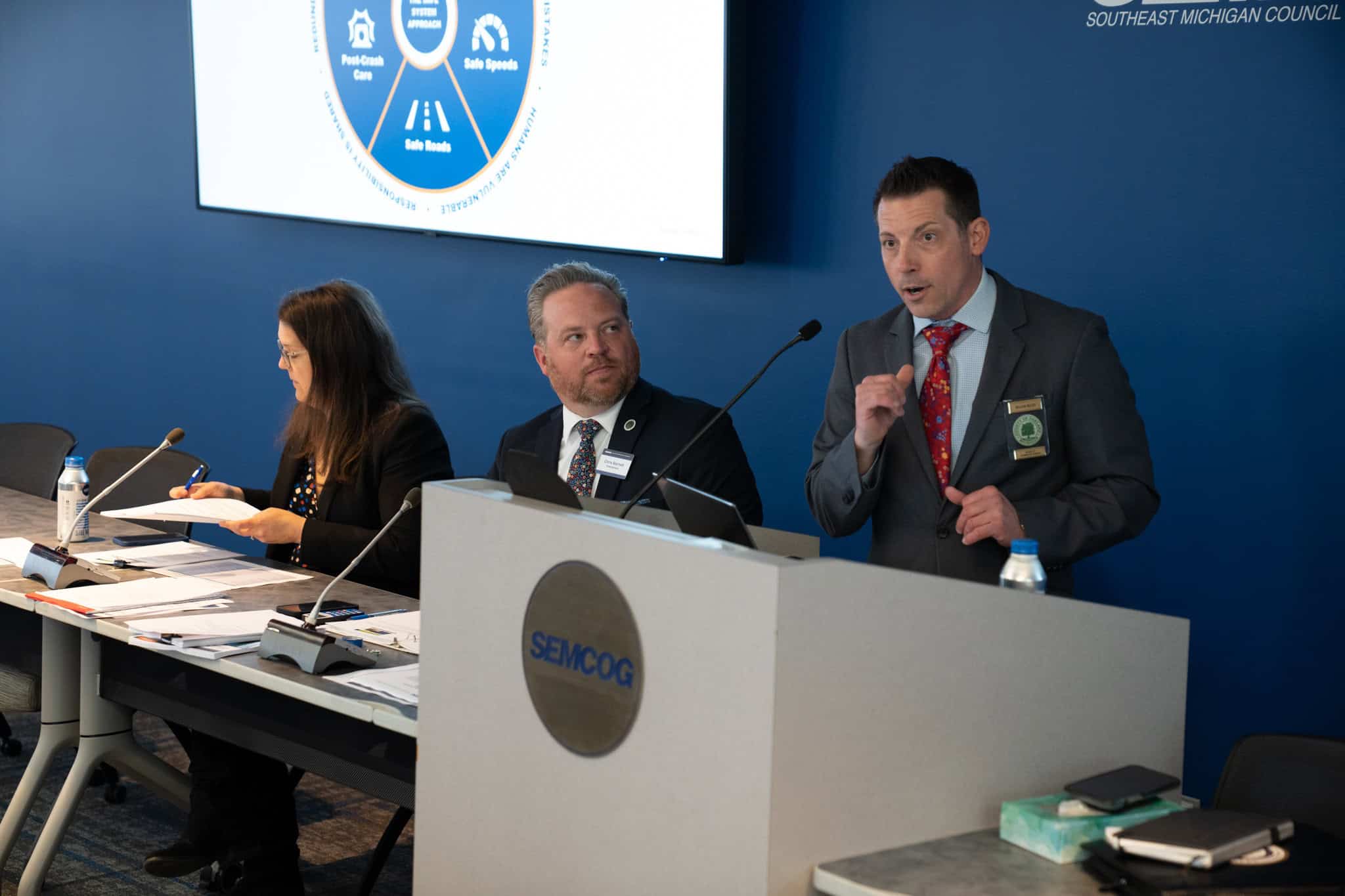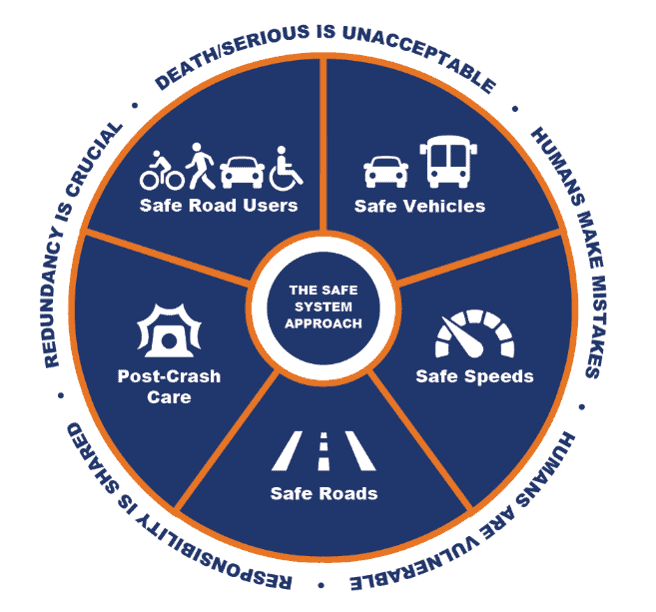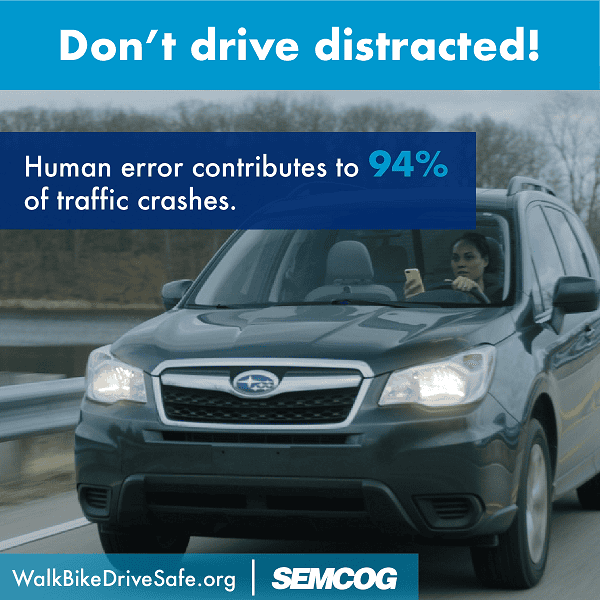At best, an automobile crash is the start of a minor inconvenience in your day. At worst, a traffic crash can abruptly end in devastating injury or death. There are more than 100,000 crashes in Southeast Michigan each year. Fortunately, relatively few of these result in fatalities or serious injuries. However, even one fatality is too many, and they are becoming more common each year. Some types of crashes are more likely to result in tragic outcomes. We also know which types of environments and behaviors lead to the worst types of crashes.

William Miller, Oakland County Commissioner, speaking at April’s Executive Committee meeting
To address the region’s safety challenges, the Southeast Michigan Transportation Safety Task Force, led by Chairperson William Miller, Oakland County Commissioner, and Vice Chairperson Michelle Nard, Macomb County Commissioner, has chosen the Safe System Approach. This approach means we need to prevent crashes, especially severe ones.
It is inevitable that people will make mistakes and crashes will happen, but we need to minimize the consequences of those collisions. This is why the task force selected a multi-layered approach, which features five regional policies in the updated Southeast Michigan Transportation Safety Plan:
- Safer People
- Safer Roads
- Safer Vehicles
- Safer Speeds
- Post-Crash Care

In addition to these five elements are the “six E’s” of safety, which are – Engineering, Education, Enforcement, Emergency Response, Equity, and Evaluation.
This plan builds on the 2015 Southeast Michigan Traffic Safety Plan and will be considered for adoption by SEMCOG’s General Assembly this summer.
Walk.Bike.Drive. Safe – Encouraging Safer People
SEMCOG, along with community partners throughout the Southeast Michigan region, has promoted safe behaviors with the Walk.Bike.Drive. Safe initiative for the past five years. In that time, WBDS messages and materials have been shared over 116 million times on television, radio, streaming, social media, and with actual safety items such as bike lights and reflective, light-up armbands. This reach represents a significant implementation activity of the region’s safety plan.
Distractions are a significant challenge in transportation safety. While the data can be hard to pin down (how many people will admit to not paying attention after they crash?), people who give a higher level of focus to walking, biking, and driving are more likely to avoid a crash. Walk.Bike.Drive. Safe is especially targeted at reducing the number of crashes involving people who walk and bike, as they are the most vulnerable to serious injuries and fatalities.
Slow down and watch for other people in the road. There’s no need to speed.
“Mean” Roads
Inclusive planning is good planning. A couple well known (and well-used, but for good reason!) examples of this include curb cuts, which allow individuals in wheelchairs to transition from the sidewalk into the street, and the ADA warning pad or “bumpy strip” (these are often red in our region), which signals to visually impaired people that they are approaching an intersection. These enhancements became requirements for the express purpose of making the environment a little easier to navigate for a relatively small percentage of people. But these “special considerations” to help a few people had a surprising effect: they actually made the environment friendlier for a lot of people. Parents no longer have to strain to gently lift and lower baby strollers when crossing the street. They can focus on safely looking both ways. Parents can also remind their children, once they’re old enough to walk themselves, to wait behind the red “bumpy strip” until it is safe to cross the street. This amenity – while designed for the vision-impaired – helps us all see our way to safety while the curb cut helps us all reach safety a bit more easily.
This winter, SEMCOG staff visited Programs to Educate All Cyclists (PEAC) to learn more about the transportation and communication needs of people with cognitive disabilities. PEAC staff and program participants walked SEMCOG staff through some of their greatest challenges, as well as how several of these can be mitigated. One of the key takeaways documented in the Public Participation Plan for Southeast Michigan, also under consideration by SEMCOG this summer, is that “mean” roads and places are a major challenge for people with cognitive impairments.
For people with cognitive impairments, “mean” roads are characterized by:
- Cars honking loudly
- People yelling
- Cars moving very fast
- Lack of sidewalks and/or curb cuts
- Bus stops that are difficult to reach
- Drivers/vehicles turning without looking for or yielding to people who walk, bike, and roll
It is important for communities to understand the unique needs and challenges of population groups – such as the cognitively impaired – and work to address them. While the challenges above were specifically expressed by individuals with cognitive impairments, they are not unique to this population. People with above-average intelligence also feel much safer in environments that lack these “mean” characteristics.
Making our roads and places nicer
Safe driving requires focus and patience. We all know these virtues can be in short supply, especially at the end of a long day or if we are running late. Changing behaviors is difficult, especially behaviors that have become habits. Think about your own driving habits or the habits of the typical driver in Southeast Michigan. None of us get behind the wheel with the intention of being mean, dangerous, or scary, but do any of our behaviors contribute to “mean” roads? If we drove a little slower, with a little more care for the people in our environment, could we contribute to a nicer place for people of all ages and abilities?

Avoid distractions, including talking or texting on your phone, while driving, biking, or walking.
Of course, many safety challenges cannot be overcome merely by the individual actions of people who walk, bike, drive, and roll – at least not alone. As indicated in the list of policies above “safer people” are just the first piece of the puzzle To create the kinds of “nice” roads and places that make people of all cognitive abilities feel safer, communities throughout Southeast Michigan are working to create complete streets that usable by everyone, not just people who drive.
As these efforts continue, today is a great day to remember that every trip to work, school, the gym, or the market is an opportunity to practice becoming a safer person. To make our roads as nice and safe as possible, we need everyone to take responsibility for safety. So on your next trip, be sure to pack your patience and attention; they could save a life, and that life might be your own.
Learn more at SEMCOG’s Safety and Security page and Walk.Bike.Drive. Safe page.

Leave a Reply